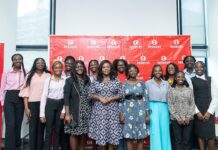The National Petroleum Authority (NPA) will start full implementation of the Cylinder Recirculation Model (CRM) in September this year, the Authority’s deputy Chief Executive Officer, Perry Curtis Kwabla Okudzeto, has said.
The CRM aims to ensure that by 2030, 50 percent of Ghanaians have access to safe, clean and environmentally friendly LPG; thereby promoting its extensive use in domestic, commercial and industrial sectors.
At a media briefing in Accra to update journalists on progress made in the recirculation programme, Mr. Okudzeto, emphasised that challenges encountered during the CRM pilot phase played a crucial role in shaping the framework for the upcoming full implementation in September.
The framework, he explained, was developed through a robust collaboration and partnership among essential stakeholders in the LPG sector: such as LPG marketing companies, Ghana LPG Operators Association, Gas Tanker Drivers Association, Association of Oil Marketing Companies, Tanker Drivers Union and the Chamber of Bulk Oil Distributors.
It encompasses various aspects including the market structure, licencing regime, guidelines, standard operating procedures and more.
Mr. Okudzeto explained that the committee has established a new licencing category within the framework, which incorporates bottling plants and cylinder transportation companies.
This addition, he added, aims to enhance efficiency and safety of LPG distribution under the CRM.
“So far, since 2017, the first step has been to construct bottling plants that will be the main pivot around which the policy will operate, since under the new policy cylinders are going to be filled with LPG and sent to exchange points for distribution,” he stated.
He disclosed that four bottling plants are ready for operation.
On his part, Obed Kraine Boachie of the Authority’s Gas Directorate said the NPA is ready to fully implement the CRM next month, saying: “This policy has come a long way and we think this is the best time for a full roll out”.
He said: “The national LPG promotion policy’s goal is to achieve 50 percent access by 2030. Per the recent population census, access to LPG is hovering at around 35 percent – and back then in 2017 when we submitted the policy to Cabinet, the access was around 23 percent. So the goal was to double access to LPG by 2030, and that goal is still relevant”.
Mandate
On October 30, 2017, the Ministry of Energy issued a letter instructing the National Petroleum Authority (NPA) to form an implementation committee responsible for planning, overseeing and ensuring a successful execution of the National LPG Promotion Policy.
The committee began its activities on November 17, 2017, and as part of its mandate conducted working visits to several countries where CRM was already in operation. Those visits were to gain insights into the supply chain dynamics, regulatory framework and challenges associated with CRM implementation.
The three groups from the committee visited Morocco, Senegal, India, Cote d’Ivoire, Colombia and Peru to gather valuable information for developing the best strategy to implement the CRM model effectively.
To ensure a seamless implementation process, LPG refilling plants will undergo a risk assessment by the NPA to classify them as either low or high risk based on their compliance with safety standards.
High-risk refilling stations will be promptly converted into filled cylinder retail and distribution outlets, while low-risk refilling stations will be exclusively designated for the supply of autogas, with enhanced safety measures in place.
This classification and transformation approach aims to optimise safety and efficiency within the LPG sector under the CRM.










